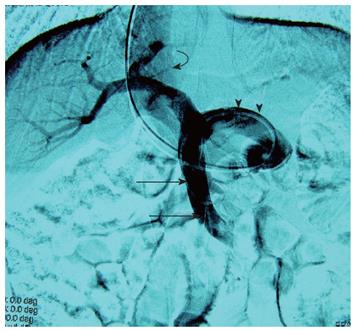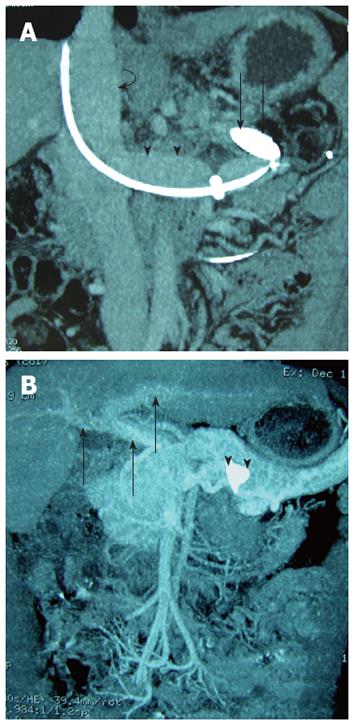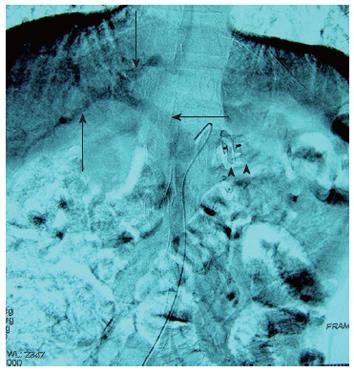Copyright
©2012 Baishideng Publishing Group Co.
World J Gastroenterol. Dec 21, 2012; 18(47): 7104-7108
Published online Dec 21, 2012. doi: 10.3748/wjg.v18.i47.7104
Published online Dec 21, 2012. doi: 10.3748/wjg.v18.i47.7104
Figure 1 Digital subtraction portogram obtained via a catheter inserted through the distal splenorenal shunt into the superior mesenteric vein (arrows) using the right jugular vein approach.
The wide patent splenorenal shunt (arrow heads) is shown. Note the inferior vena cava (curved arrow).
Figure 2 Coronal maximum intensity projection reconstruction of a contrast enhanced 64-slice helical computed tomography scan of the abdomen.
A: Obtained 5 d after placement of an occlusion through the splenorenal shunt and shows the occlusion balloon placed within the shunt tract (arrows), note the inferior vena cava (curved arrow) and the left renal vein (arrow heads); B: Obtained 3 mo after the Amplatzer vascular plugs (AVP) occlusion procedure and shows the correct AVP position (arrow heads), opacification of the portal system (arrows), and no opacification of the surgical shunt, as well as the varices.
Figure 3 After deploying the Amplatzer vascular plugs, indirect digital subtraction portography, obtained through the catheter inserted into the superior mesenteric artery using the right femoral artery approach, demonstrates opacification of the portal vein (arrows).
Note the correct Amplatzer vascular plugs position (arrow heads) and no visualization of varices.
Figure 4 Axial image of contrast enhanced 64-slice helical computed tomography scan of the abdomen, showing the correct Amplatzer vascular plug position (curved arrow), opacification of the portal system (arrow heads), and a thrombosed shunt tract (arrows).
- Citation: Wang MQ, Liu FY, Duan F. Management of surgical splenorenal shunt-related hepatic myelopathy with endovascular interventional techniques. World J Gastroenterol 2012; 18(47): 7104-7108
- URL: https://www.wjgnet.com/1007-9327/full/v18/i47/7104.htm
- DOI: https://dx.doi.org/10.3748/wjg.v18.i47.7104












